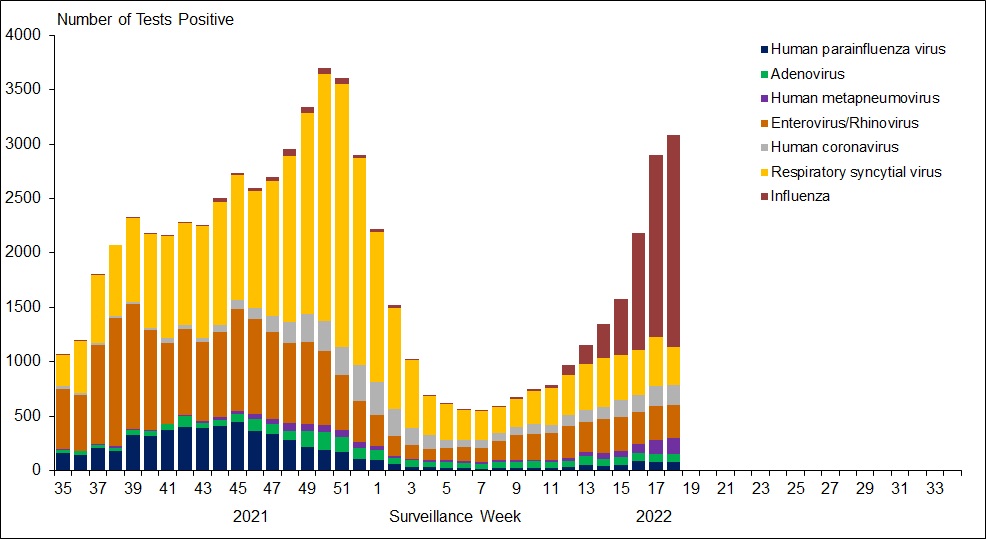
Influenza, the common cold, seasonal allergies and COVID-19. The month of May is as synonymous with sunshine and warmth as runny noses and a scratchy throat with flowers blooming and bees pollinating.
What makes people uneasy is how symptoms directly compare to COVID-19 and how best to differentiate signs of allergies from that of the coronavirus.
But what about the common cold and influenza (the flu)? According to Health Canada’s most recent weekly influenza report — which examined flu cases from April 17 to May 7 — since the beginning of April, detections of influenza have sharply increased and have met seasonable thresholds.
Health Canada says just under 5,000 laboratory cases of influenza were detected in the country in the weeks mentioned. Among the cases with precise age data, the majority were individuals under the age of 45 years.
Health Canada notes that increases in flu-like illness and hospitalizations are currently taking place, adding that elevated flu activity — 249 influenza-associated hospitalizations — has occurred over the past few weeks.
Additional statistics show that the percentage of Canadians reporting “influenza-like illness (ILI)” to doctors was 2.1 per cent.
“The percentage visits for ILI has now exceeded the pre-pandemic levels typical of this time of year,” Health Canada says, adding that the IMPACT network has seen a “sharp increase” in influenza-associated hospitalizations among the pediatric population.

That data seems to align with what Chicago has reported in recent days. According to city data, there were about 300 known flu cases a week throughout April and during the first part of May. The city uses data on test results reported by several Chicago hospital labs.
By comparison, there were just tens of cases a week throughout most of January and February.
Officials with Health Canada say that detections of seasonal respiratory viruses have also increased since February 2022, with influenza accounting for most of the growth in recent weeks. Health Canada says that the activity of most respiratory viruses is within or below expected levels for this time of year.
“Influenza is the most common seasonal respiratory virus detected in Canada as we conclude the third week of the influenza season,” writes the Public Health Agency of Canada.
“[The] activity of other respiratory viruses is low; however, the activity of seasonal human coronavirus (178 detections; 4.8 per cent positive) remains slightly above expected levels.”
Meanwhile, Health Canada data shows Rhinovirus test positivity — the main culprit behind the common cold — is up slightly compared to past weeks, including higher detection in Ontario compared to other provinces.
Ontario is reporting 11 new deaths linked to COVID-19 today. The province says that figure includes deaths from previous days recorded during a data clean-up. There are 1,345 people hospitalized with the virus today, up from 1,122.
Comparing flu, cold symptoms with COVID-19: What to know
COVID-19, the common cold, seasonal allergies and the flu have many similar signs and symptoms, notes Mayo Clinic.
Health officials continue to stress that the most common symptoms of COVID-19 are fever, cough and tiredness.
Symptom |
COVID-19 |
Cold |
|---|---|---|
| Cough | Usually (dry) | Usually |
| Muscle aches | Usually | Sometimes |
| Tiredness | Usually | Sometimes |
| Sneezing | Rarely | Sometimes |
| Sore throat | Usually | Usually |
| Runny or stuffy nose | Usually | Usually |
| Fever | Usually | Sometimes |
| Diarrhea | Sometimes | Never |
| Nausea or vomiting | Sometimes | Never |
| New loss of taste or smell | Usually (early — often without a runny or stuffy nose) | Sometimes (especially with a stuffy nose) |
COVID-19 symptoms typically appear two to 14 days after exposure, while signs of a common cold generally start to show one to three days after exposure to a cold-causing virus.
Most healthy individuals recover from a common cold in three to 10 days, although some colds may linger for two or three weeks.
The flu works differently. Compared to COVID-19, it’s less transmissible, and COVID-19 can also take longer before people show symptoms. People can remain contagious for longer periods of time.
The Centre Centers for Disease Control and Prevention (CDC) says you cannot tell the difference between flu and COVID-19 just by looking at the symptoms because they show some of the same signs.
Typically, a person may experience flu-like symptoms anywhere from 1 to 4 days after infection. Most people with influenza are contagious for about one day before they show symptoms, while older children and adults appear to be most contagious during the first three-to-four days of their illness.
Most people who get flu will recover on their own in a few days to two weeks.
Symptom |
COVID-19 |
Flu |
|---|---|---|
| Cough | Usually (dry) | Usually |
| Muscle aches | Usually | Usually |
| Tiredness | Usually | Usually |
| Sore throat | Usually | Usually |
| Runny or stuffy nose | Usually | Usually |
| Fever | Usually | Usually — not always |
| Nausea or vomiting | Sometimes | Sometimes (more common in children) |
| Diarrhea | Sometimes | Sometimes (more common in children) |
| Shortness of breath or difficulty breathing | Usually | Usually |
| New loss of taste or smell | Usually (early — often without a runny or stuffy nose) | Rarely |







